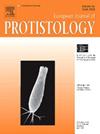尾虫多样性的组成:揭示作物植物的叶、根和土壤特异性
IF 1.6
2区 生物学
Q4 MICROBIOLOGY
引用次数: 0
摘要
原生生物是植物整体生物群的组成部分,通过其捕食活动影响植物的生长和致病压力。小麦(Triticum aestivum)是全球最重要的作物之一,其高产依赖于良好的环境条件和有效的病原菌管理。本研究调查了两个田间季节冬小麦在不同发育阶段(播种前、开花、成熟和收获后)和植物区隔(叶、根、根际和散装土壤)中cercozoa多样性的自然组成。结果显示,在所有样本中,沙蚕科、沙蚕科、沙蚕科和红蝇科均占明显优势。叶样中沙盆科和根样中Allapsidae的富集尤为显著。重要的是,在植物的不同发育阶段观察到的尾蚴组成没有显著差异。小麦(Triticum aestivum)和大麦(Hordeum vulgare)在土壤、叶片和根室的尾蚴多样性上有很大的相似性,只有成熟阶段的叶片样品存在显著差异。研究结果表明,冬小麦的尾蚴多样性具有室特异性,并在整个发育阶段保持稳定。需要进一步的研究来探索更大的分类深度和阐明它们的生态作用。未来的研究还应评估是否在其他主要农作物中也观察到类似的区隔变异模式和发育一致性。本文章由计算机程序翻译,如有差异,请以英文原文为准。

Composition of cercozoan diversity: Unravelling leaf, root, and soil specificity in crop plants
Protists are integral components of the plant holobiome, influencing plant growth and pathogenic pressure through their predatory activities. Wheat (Triticum aestivum), one of the most important crops globally, depends on favorable environmental conditions and effective pathogen management to achieve high yields. This study investigates the natural compositions of cercozoan diversity in winter wheat across various developmental stages (before sowing, at flowering, at ripening, and after harvesting) and plant compartments (leaves, roots, rhizosphere, and bulk soil) over two field seasons. The results revealed a pronounced dominance of the families Sandonidae, Allapsidae, Cercomonadidae, and Rhogostomidae across all samples. A strong enrichment of Sandonidae in leaf samples and Allapsidae in root samples was particularly notable. Importantly, no significant differences in cercozoan composition were observed across the different developmental stages of the plant. A comparative analysis between Triticum aestivum and Hordeum vulgare (barley) showed substantial similarity in cercozoan diversity across soil, leaf, and root compartments, with the only notable difference occurring in leaf samples during the ripening stage. The study concludes that cercozoan diversity in winter wheat is compartment-specific and remain stable across developmental stages. Further research is needed to explore cercozoan communities in greater taxonomic depth and to elucidate their ecological roles. Future studies should also assess whether similar patterns of compartmental variation and developmental consistency are observed in other major agricultural crops.
求助全文
通过发布文献求助,成功后即可免费获取论文全文。
去求助
来源期刊

European journal of protistology
生物-微生物学
CiteScore
4.60
自引率
20.70%
发文量
55
审稿时长
14.6 weeks
期刊介绍:
Articles deal with protists, unicellular organisms encountered free-living in various habitats or as parasites or used in basic research or applications. The European Journal of Protistology covers topics such as the structure and systematics of protists, their development, ecology, molecular biology and physiology. Beside publishing original articles the journal offers a forum for announcing scientific meetings. Reviews of recently published books are included as well. With its diversity of topics, the European Journal of Protistology is an essential source of information for every active protistologist and for biologists of various fields.
 求助内容:
求助内容: 应助结果提醒方式:
应助结果提醒方式:


